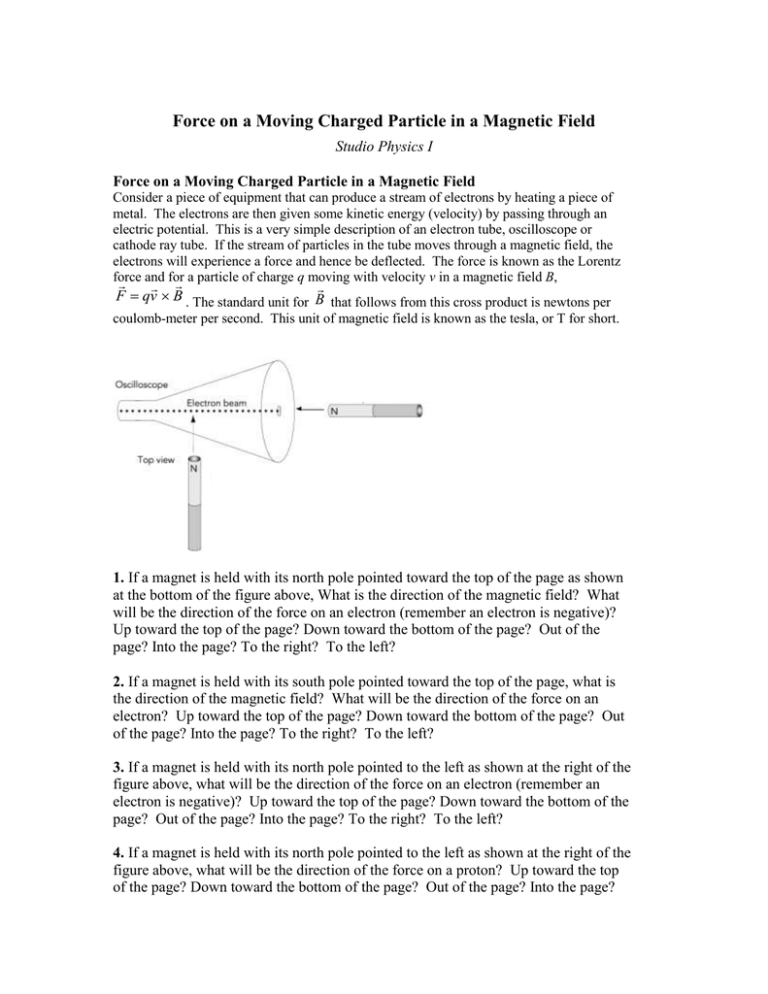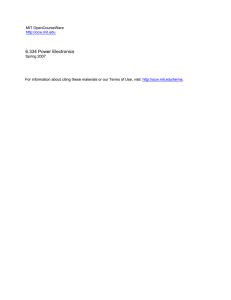Force on a Moving Charged Particle in a Magnetic Field
advertisement

Force on a Moving Charged Particle in a Magnetic Field Studio Physics I Force on a Moving Charged Particle in a Magnetic Field Consider a piece of equipment that can produce a stream of electrons by heating a piece of metal. The electrons are then given some kinetic energy (velocity) by passing through an electric potential. This is a very simple description of an electron tube, oscilloscope or cathode ray tube. If the stream of particles in the tube moves through a magnetic field, the electrons will experience a force and hence be deflected. The force is known as the Lorentz force and for a particle of charge q moving with velocity v in a magnetic field B, F qv B . The standard unit for B that follows from this cross product is newtons per coulomb-meter per second. This unit of magnetic field is known as the tesla, or T for short. 1. If a magnet is held with its north pole pointed toward the top of the page as shown at the bottom of the figure above, What is the direction of the magnetic field? What will be the direction of the force on an electron (remember an electron is negative)? Up toward the top of the page? Down toward the bottom of the page? Out of the page? Into the page? To the right? To the left? 2. If a magnet is held with its south pole pointed toward the top of the page, what is the direction of the magnetic field? What will be the direction of the force on an electron? Up toward the top of the page? Down toward the bottom of the page? Out of the page? Into the page? To the right? To the left? 3. If a magnet is held with its north pole pointed to the left as shown at the right of the figure above, what will be the direction of the force on an electron (remember an electron is negative)? Up toward the top of the page? Down toward the bottom of the page? Out of the page? Into the page? To the right? To the left? 4. If a magnet is held with its north pole pointed to the left as shown at the right of the figure above, what will be the direction of the force on a proton? Up toward the top of the page? Down toward the bottom of the page? Out of the page? Into the page? To the right? To the left? Understanding why a charge moving perpendicular to a magnetic field moves in a circle. 5. Consider an electron that is shot with velocity v from left to right in the presence of a uniform magnetic field B that is into the paper. This is indicated by the X’s in the figure below. In the next moment after it is launched, will the electron still be traveling in the same straight line? Why or why not? Sketch this figure on your paper and show what its trajectory might be in the next moment. 6. If the force on the moving charged particle due to the magnetic field is perpendicular to the direction of motion of the electron in the first moment, is it still perpendicular in the second moment? In the third moment? Why or why not? 7. If the force is always perpendicular to the direction of motion, is any work done on the particle as it moves in a short but curved path (not a complete circle)? Recall that the formal definition of work for a small displacement ds is given by the equation dW F • ds . If so, how much work is done? If not, why not? 8. If no work is done on the electron as it moves, does its speed (that is, the magnitude of its velocity) change or remain the same? Does this particle undergo an acceleration? Why or why not? 9. The displacement of an electron bending in a magnetic field is shown in the figure below for two moments. Copy this diagram onto your paper and complete the diagram for the next several moments of time. Thus show the shape of the path of the electron in the magnetic field. 10. Suppose, you broke the path above up into a huge number of tiny steps. What would the shape of the path be? How might it change if you increase the magnitude of the magnetic field? Why? Magnetic Field of the Earth One way to produce a magnetic field is to pass a current through a coil of wire. B N 0 i 2 R , where For the single coil, the magnetic field can be calculated from the formula: N is the number of turns of wire on the coil, i is the current in the coil, and R is the radius of the coil. (N = 15 and R = 0.075 m) We will indirectly measure the magnetic field of the earth by producing a matching magnetic field using a coil. The magnetic field produced by a current carrying coil of wire is perpendicular to the plane of the coil. If we place compass at the center of the coil, the compass needle will point in the direction of the magnetic field at that spot. However, the magnetic field at that spot is the vector sum of the earth's magnetic field and the magnetic field produced by the coil. Start with no current running through the coil of wire. Place the compass on the platform at the center of the coil. Align the compass so that the north-south line is perpendicular to the plane of the coil. Next, rotate the coil (with the compass at its center) so that the compass needle is exactly aligned with the east-west line of the compass. You now have the coil oriented so that the earth's magnetic field is parallel to the plane of the coil. 11. If the earth's magnetic field is parallel to the plane of the coil and the magnetic field produced by the coil is perpendicular to the plane of the coil, at what angle will the compass needle point if the earth's magnetic field is exactly equal in magnitude to the magnetic field produced by the current carrying coil? 12.Turn the current in the coil up and record the value of current, which is found to deflect the compass needle to the angle you found in #1 above. Turn down the current. 13. Repeat step #2 five times. Be sure to turn down the current in the coil between readings. Find the average of these current measurements. Use the equation at the top of the page to calculate the magnetic field produced by the coil. 14. What is the magnitude of the earth's magnetic field? 15. Explain how the earth’s magnetic field protects us from charged particles moving through space that enter our atmosphere.





